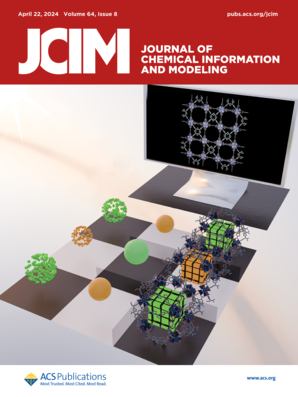Structure-Directed Pan-Specific T-Cell Receptor-Peptide-Major Histocompatibility Complex Interaction Prediction.
IF 5.6
2区 化学
Q1 CHEMISTRY, MEDICINAL
引用次数: 0
Abstract
T-cell receptors (TCRs) play a pivotal role in the adaptive immune system, and understanding their antigen recognition mechanism remains a critical area of research. With the increasing availability of binding and interaction data between TCRs and peptide-major histocompatibility complexes (pMHCs), data-driven computational methods are emerging as powerful tools with significant potential for advancement. In this study, we collected and curated comprehensive sequence and structure data sets of TCRs from human CD8+ T-cells and cognate epitopes presented by MHC class I molecules. We developed two innovative computational frameworks: SG-TPMI, a lightweight, extensible, and structure-guided model for predicting TCR-pMHC binding specificity, and Seq/Struct-TCS, a pair of models (sequence-based and structure-based) for predicting contact sites within TCR-pMHC complexes. Notably, we directly integrated MHC-I alpha helices (or pseudosequences) and structural information on the protein complex into the prediction models. Our comprehensive modeling approach enabled quantitative investigations of TCR-pMHC interaction mechanisms, empowering SG-TPMI and Struct-TCS to achieve performances comparable to those of state-of-the-art methods. Furthermore, our results highlight the necessity of CDR1 and CDR2 loops as well as MHC restriction in pan-specific TCR-pMHC interaction prediction, providing new insights into TCR recognition. In summary, we not only propose SG-TPMI as an effective computational method for predicting TCR-pMHC binary interactions but also introduce the Seq/Struct-TCS design for predicting TCR interacting sites with peptide or MHC alpha helices.结构导向的泛特异性t细胞受体-肽-主要组织相容性复合物相互作用预测。
t细胞受体(TCRs)在适应性免疫系统中发挥着关键作用,了解其抗原识别机制仍然是一个重要的研究领域。随着tcr与肽-主要组织相容性复合物(pmhc)之间的结合和相互作用数据的可用性越来越高,数据驱动的计算方法正在成为具有重大发展潜力的强大工具。在这项研究中,我们收集并整理了来自人CD8+ t细胞和MHC I类分子同源表位的tcr的综合序列和结构数据集。我们开发了两个创新的计算框架:SG-TPMI,用于预测TCR-pMHC结合特异性的轻量级、可扩展和结构导向模型,以及Seq/Struct-TCS,用于预测TCR-pMHC配合物中接触位点的一对模型(基于序列和基于结构)。值得注意的是,我们直接将MHC-I α螺旋(或假序列)和蛋白质复合物的结构信息整合到预测模型中。我们的综合建模方法能够定量研究TCR-pMHC相互作用机制,使SG-TPMI和Struct-TCS达到与最先进方法相当的性能。此外,我们的研究结果强调了CDR1和CDR2环以及MHC限制在泛特异性TCR- pmhc相互作用预测中的必要性,为TCR识别提供了新的见解。综上所述,我们不仅提出SG-TPMI作为预测TCR- pmhc二元相互作用的有效计算方法,而且还引入了Seq/Struct-TCS设计来预测TCR与肽或MHC α螺旋的相互作用位点。
本文章由计算机程序翻译,如有差异,请以英文原文为准。
求助全文
约1分钟内获得全文
求助全文
来源期刊
CiteScore
9.80
自引率
10.70%
发文量
529
审稿时长
1.4 months
期刊介绍:
The Journal of Chemical Information and Modeling publishes papers reporting new methodology and/or important applications in the fields of chemical informatics and molecular modeling. Specific topics include the representation and computer-based searching of chemical databases, molecular modeling, computer-aided molecular design of new materials, catalysts, or ligands, development of new computational methods or efficient algorithms for chemical software, and biopharmaceutical chemistry including analyses of biological activity and other issues related to drug discovery.
Astute chemists, computer scientists, and information specialists look to this monthly’s insightful research studies, programming innovations, and software reviews to keep current with advances in this integral, multidisciplinary field.
As a subscriber you’ll stay abreast of database search systems, use of graph theory in chemical problems, substructure search systems, pattern recognition and clustering, analysis of chemical and physical data, molecular modeling, graphics and natural language interfaces, bibliometric and citation analysis, and synthesis design and reactions databases.

 求助内容:
求助内容: 应助结果提醒方式:
应助结果提醒方式:


